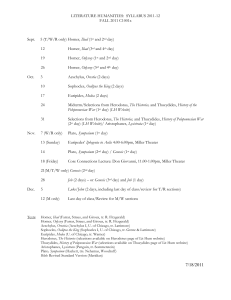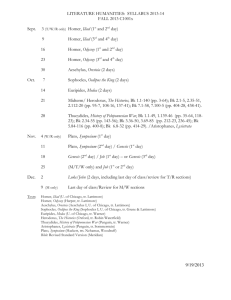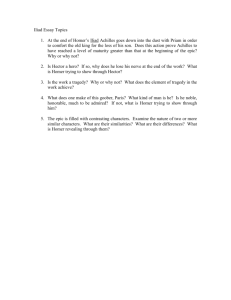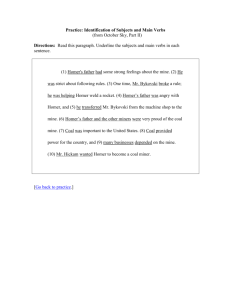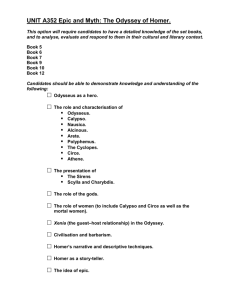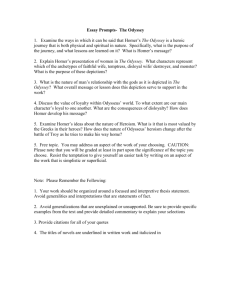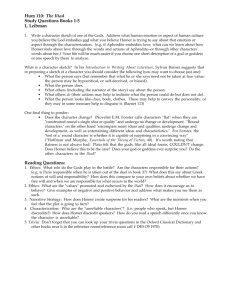Notes on the Æthiopica, the Lives of Homer, and the Name - H-Net
advertisement
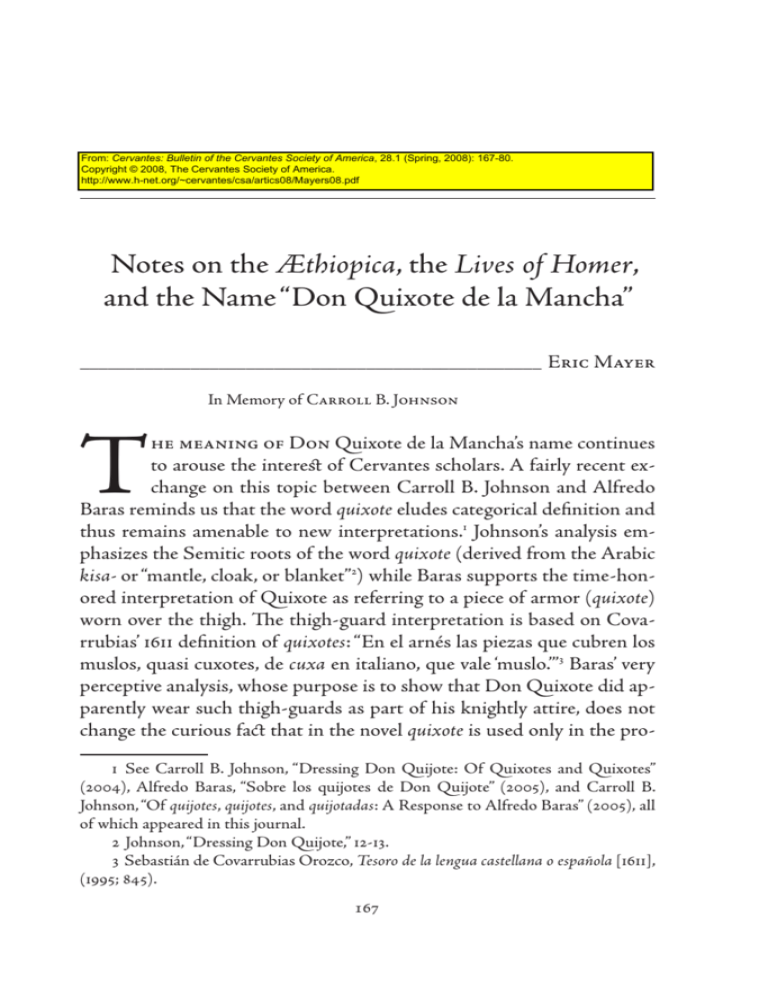
From: Cervantes: Bulletin of the Cervantes Society of America, 28.1 (Spring, 2008): 167-80. Copyright © 2008, The Cervantes Society of America. http://www.h-net.org/~cervantes/csa/artics08/Mayers08.pdf Notes on the Æthiopica, the Lives of Homer, and the Name “Don Quixote de la Mancha” __________________________________________________ Eric Mayer In Memory of Carroll B. Johnson T he meaning of Don Quixote de la Mancha’s name continues to arouse the interest of Cervantes scholars. A fairly recent exchange on this topic between Carroll B. Johnson and Alfredo Baras reminds us that the word quixote eludes categorical definition and thus remains amenable to new interpretations.1 Johnson’s analysis emphasizes the Semitic roots of the word quixote (derived from the Arabic kisa- or “mantle, cloak, or blanket”2) while Baras supports the time-honored interpretation of Quixote as referring to a piece of armor (quixote) worn over the thigh. The thigh-guard interpretation is based on Covarrubias’ 1611 definition of quixotes: “En el arnés las piezas que cubren los muslos, quasi cuxotes, de cuxa en italiano, que vale ‘muslo.’”3 Baras’ very perceptive analysis, whose purpose is to show that Don Quixote did apparently wear such thigh-guards as part of his knightly attire, does not change the curious fact that in the novel quixote is used only in the pro1 See Carroll B. Johnson, “Dressing Don Quijote: Of Quixotes and Quixotes” (2004), Alfredo Baras, “Sobre los quijotes de Don Quijote” (2005), and Carroll B. Johnson, “Of quijotes, quijotes, and quijotadas: A Response to Alfredo Baras” (2005), all of which appeared in this journal. 2 Johnson, “Dressing Don Quijote,” 12-13. 3 Sebastián de Covarrubias Orozco, Tesoro de la lengua castellana o española [1611], (1995; 845). 167 168 Eric Mayer Cervantes tagonist’s name and never to describe his armor; quixote never is defined in the novel through usage. This, in turn, obliges a reader to reflect on the possible meaning of the Manchegan knight’s name.4 For my part, I would like to propose a reading of the name “Don Quixote de la Mancha” that places it within a comparative literary context which includes the Æthiopica by Heliodorus and the various Lives of Homer. I will argue that there exists a meaningful etymological relationship between Don Quixote’s name and that of Homer specifically as presented in the Æthiopica, a text Cervantes knew well. The coincidences posed by the names, plus Cervantes’ direct comparison of Don Quixote to Homer in DQ II, 74 will provide occasion to reflect on how the “true” lives of Quixote and Homer are only accessible via multiple authors and contradictory texts. In a subtle play of words, Cervantes might have invented the name Don Quixote de la Mancha to allude to Homer, a literary figure defined in the Lives of Homer as much by his status as epic poet as by the total uncertainty surrounding his biography. The word quixote is intrinsically associated with the concept of thigh. The concept of thigh, in turn, has special significance within the epic tradition. Here, one might recall Auerbach’s masterful analysis of Odysseus’ scarred thigh in his study Mimesis (1957, 1-20). Eurycleia’s recognition of the scar in the Odyssey (bk. 19) triggers a retrospective narration which plunges the reader deep into Odysseus’ past, specifically to an incident when he was gored in the thigh by a boar during a hunt. In addition to Odysseus, it was Homer himself who would have been associated with the thigh in Cervantes’ era. To illustrate this, one must return to Heliodorus’ Æthiopica, a work widely read in Spanish translation in Golden Age Spain and very influential over Cervantes, Lope, Calderón, Mateo Alemán, and other writers of the era.5 To be sure, the relationship be4 Spitzer [1948 (1961)] describes the “perspectivismo lingüístico” of Don Quixote as being based on “la inestabilidad y variedad de los nombres dados a algunos personajes (y la variedad de explicaciones etimológicas de esos mismos nombres)” (135). 5 As is well known, in the prólogo to the Novelas ejemplares (1613) Cervantes describes the Persiles as a “libro que se atreve a competir con Heliodoro” (I, 53). Lope was influenced by the Æthiopica in writing his novel El peregrino en su patria (1604) and references Heliodorus’ work in the play La dama boba (III, 2117-18; 235). Calderón craft- Volume 28.1 (2008) Notes on the Name “Don Quixote” 169 tween Don Quixote, Homer, and thigh does not leap out from the plot of the Æthiopica. In fact, the passage in question is to be found in Book III deeply embedded within Calasiris’ lengthy retrospective narration. Here, Calasiris gives a brief summary of Homer’s life and reveals that the name Homer is associated with the Greek word for muslo or thigh. Why Homer was given this name is explained here by Calasiris: “Su padre, en la opinión de las gentes, fué un sacerdote; mas el que realmente le engendró fué Mercurio, y pensaban que no, sino el sacerdote. Porque como su mujer, estando haciendo ciertos sacrificios, quedase de noche en el templo, durmió con ella el dios y quedó preñada de Homero, el cual sacó del vientre de su madre una señal clara y manifiesta de aquel incestuoso ayuntamiento, porque en el uno de los muslos sacó gran cantidad de vello muy largo. Y después, andando por muchas tierras y principalmente por la Grecia cantando su poesía, ganó el nombre de Homero, porque sin decir él ni descubrir su propio nombre ni su patria ni su linaje, los que sabían aquella señal de su muslo se la dieron por propio nombre” (III, 133). 6 Calasiris’ suggestion that the name Homer refers to “muslo” is what we will focus on for the moment. While Mena does not explicitly transed Los hijos de la fortuna, Teágenes y Cariclea (1664) based on the Æthiopica. Donald McGrady (1966) establishes how the Æthiopica inspired Mateo Alemán to compose the tale “Ozmín y Daraja” which he interpolated in Guzmán de Alfarache (1599, 1604). For a general discussion of the Æthiopica’s influence on the novel genre see Doody (1997; especially pp. 233-46 which cover the book’s reception during the Renaissance). Key studies that document Heliodorus’ influence on Cervantes and other Spanish writers of fiction are the prólogo in Francisco López Estrada’s edition of the Historia etiópica (1954) and the two studies by Rudolph Schevill (1906 and 1907). The Æthiopica is referenced vis-à-vis Cervantes throughout the studies of Alban K. Forcione (1970 and 1972). Marcel Bataillon [1937 (1966)] briefly examines the Æthiopica’s reception among Spanish humanists in the sixteenth century (see pp. 244, 621-22, and 779). Albinio Martín Gabriel (1950) situates his discussion of the Æthiopica among the works of Gracián, Quevedo, and others. 6 All citations of the Spanish translation of the Æthiopica are from Heliodorus of Emesa, Historia Etiópica de los amores de Teágenes y Cariclea [1587], trans., Juan de Mena, ed., Francisco López Estrada (1954). 170 Eric Mayer Cervantes late “Homero” as “El Muslo,” the text makes clear that the poet’s name references his thigh and/or the “señal” on the thigh, given that “los que sabían aquella señal de su muslo se la dieron por propio nombre.” As a result of Mena’s lack of a direct translation, the reader retains a certain amount of leeway with which to infer any number of names reflective of the epic poet’s peculiar physical attribute, his marked thigh; some examples could be “Hairy Thigh,” “Marked Thigh,” or, as Moses Hadas translates it, “The Thigh.” 7 At any rate, we have this eminent literary figure, the epic poet Homer, whose name according to Calasiris—and by extension the many readers who took him at his word—refers directly to a part of his anatomy which also figures etymologically in the word quixote (when read as thigh-guard). Homer was named by the public for a noticeable mark of shame on his thigh (a sign of “incestuous” parentage) while Don Quixote named himself ostensibly for a piece of armor also covering the thigh. The identification of Homer’s name with thigh is clear. We know the same to be true of Don Quixote. Curiously, it happens that quixote is not the only name related to thigh that is used to refer to the knight. I am referring to when Dorotea momentarily forgets the name “Quixote” and calls the knight “Don Gigote” (DQ I, 30; 348).8 Covarrubias states that gigote derives from the French word for muslo: “Es nombre francés, GIGOT, que vale pierna, conviene a saber la que es muslo en el hombre” (589).9 Covarrubias goes on to provide a link between gigote and quixote noting that quixotes is a “corruption” of the Spanish gigotes or thighguards: “y así pienso que la palabra quijotes, que son el armadura que cae sobre el muslo, está corrompida de gigotes, armadura de los muslos” (589). Thus, Don Quixote is twice named—once purposely by himself, 7 In his English language rendering of the Greek text, Hadas translates “Homer” as “The Thigh” (1999; 79). The anonymous 1554 Spanish translation renders Homer’s name as “pierna” (III, 92). Ghini’s 1560 Italian translation reads like Mena’s and does not explicitly translate Homer’s name (III, 118). 8 All citations are from Miguel de Cervantes, Don Quijote de la Mancha, ed., Francisco Rico (1999). 9 Rico’s edition (DQ I, 30; 348, n.31) acknowledges this etymology. For more on “don Gigote” see Herrero García (1977; 26-27) and Redondo (1980; 49-50). Volume 28.1 (2008) Notes on the Name “Don Quixote” 171 once inadvertently by Dorotea—with words related to thigh. Suffice it to say that we have before us two literary figures, Don Quixote and Homer, whose names are individually defined by and associated with each other by this specific part of the anatomy. To be sure, the thigh has figured prominently in various studies of the Manchegan knight’s self-given name. It is natural that the thigh, given its anatomical location, would inspire analyses that study it within an erotic context. Alfredo Baras Escolá (1992) notes how the thigh can be related to an event in the Vida de San Ignacio de Loyola which, for seventeenth-century readers, resonated with ideas of divine punishment of sensuality.10 Regarding Don Quixote, John G. Weiger’s observation that “the anatomy surrounding the genital area” has “traditionally [been] used in literature as a euphemism for the sexual center of the human body” leads him to conclude that Don Quixote’s name choice is indicative of the knight’s desire to “cover and protect his sexuality” (1979; 35). For his part, Carroll B. Johnson would delve further into this topic to explore “why Don Quixote would want to cover up and protect his sexuality” with the thigh-guard (1983; 68). As plausible as they are, the various studies that explore the symbolic or metaphoric significance of quixote and thigh differ substantially from the Quixote-Homer association given that in none of them do we encounter other figures historical or fictional whose names reference this part of the body. This precise coincidence exists, as far as I know, only in the names of Don Quixote and Homer. Before reflecting on the possible significance of the connection between Homer and Don Quixote, still more associations can be made between the two men’s names. We recall that according to Calasiris’ account of Homer’s lineage, the name Homer was assigned to him by the public which knew of his tainted origins, something for which the poet 10 “Más en concreto, los autores del Siglo de Oro suelen remontar a fuentes bíblicas un episodio hagiográfico reciente: así es como la cojera de San Ignacio de Loyola será asociada con la de Jacob tras su lucha con un ángel (Gén. 32, 24-32) que, al herirle en el tendón del muslo izquierdo, habría castigado su sensualidad (81).” Baras includes a very useful critical history of interpreting Don Quixote’s name, as does Johnson (2004). Dominique Reyre (1980; 121-27) offers detailed etymological analyses of the different surnames attributed to Don Quixote. 172 Eric Mayer Cervantes was visibly marked by “una señal clara y manifiesta de aquel incestuoso ayuntamiento” (III, 133). News of the boy’s illegitimacy would then drive Homer’s putative father to expel him from the family home: “su padre le había echado de su casa cuando le quisieron matricular entre los mancebos consagrados al servicio de los dioses, porque le fué hallada aquella señal, por la cual fué conoscido no ser legítimo” (III, 133). However, the basis for Homer’s incestuous parentage is not readily apparent in Calasiris’ remarks above in which Mercury is described as having sired the poet. An alternative legend—one cited by Covarrubias—describes how Homer’s mother “Criteis” conceived Homer of an incestuous encounter with her brother.11 Thus, in spite of Calasiris’ obfuscation of the nature of the poet’s incestuous origins, Homer would obviously have been understood to be the product of an “impure” union of one kind or another. In sum, for readers of the Æthiopica such as Cervantes, the hairy thigh and the name Homer are the mutually reinforcing signs of the poet’s tainted origins: “una señal clara y manifiesta de aquel incestuoso ayuntamiento.” This relationship between Homer’s name, his bodily markings, and his tainted lineage could have relevance to our understanding of the name Don Quixote de la Mancha. On the one hand, Quixote is related to the thigh area while, on the other hand, the name Mancha has been interpreted as referring to the knight’s possibly tainted lineage, his “sangre manchada.” Covarrubias once again provides the definition: Mancha “[p]or alusión significa todo aquello que estraga y desdora lo que de suyo era bueno, como mancha en un linaje” (732). Curiously, Don Quixote’s full name now seems to be associated with this particular Life of Homer found in the Æthiopica, in which Homer is named for a mark on his thigh, the result of tainted lineage. For, according to standard interpretations the dual association of thigh (as a root of quixote) and tainted lineage (mancha) figures in the name Don Quixote de la Mancha. Beyond this, mancha can also mean spot, stain, or mark. And we recall that Homer’s tainted lineage was made public owing precisely to the mark on his thigh. With this in mind, one could now plausibly read the name “Quixote de 11 “Refiere Plutarco, en la vida de Homero, haberse llamado su madre Criteis, al cual concibió de un hermano suyo” (642). Volume 28.1 (2008) Notes on the Name “Don Quixote” 173 la Mancha” as “Thigh-Guard of the Mark” or “Marked Thigh-Guard.” This seemingly senseless name—“Thigh-Guard of the Mark”—suddenly acquires meaning when remembering Homer’s name which, according to Heliodorus, refers directly to the epic poet’s own marked thigh. In this way, one could view Cervantes’ use of the name “Thigh-Guard” (as opposed to “Thigh”) as a humorously chivalric distortion of Homer’s name. Deciding whether or not Cervantes and his contemporaries would have made such an intertextual association will remain a purely speculative exercise. Yet, it could be that Cervantes was not the only author to wryly connect his character’s name to the biography of Homer. For, the anonymous author of La vida de Lazarillo de Tormes (1554) might also have been referencing Homer with the name of his picaresque protagonist.12 The more pressing question is why Cervantes would ever want to 12 Covarrubias’ entry for “Homero” tells of the poet originally being named “Melesígenes” “por haberle parido [su madre] a las riberas del río Melete” (642). In Greek Melesígenes means “Meles-born,” which within the context some of the Homeric Lives [e.g., “(Pseudo-)Plutarch on Homer I,” 405 and 407] is understood to mean “on the shores of the Meles” river (or, as Covarrubias calls it, the “río Melete”) while in “The Contest of Homer and Hesiod” (319) it refers to Homers’ having been conceived by the river god “Meles” and the nymph “Creteis.” As is well known, the birth of Lazarillo “fue dentro del río Tormes,” hence his adoption of the surname Tormes (Lazarillo de Tormes, 12). Rosa Navarro Durán (2004; 46-47) had previously identified the connection between the names of Lazarillo and Homer, citing a biographical sketch included in Las CCC del famosísimo poeta Juan de Mena con glosa by Hernán Núñez (Sevilla, 1499) which describes how Homer was named “Melesígenes” after the river “Meletes” by which he was born. For further discussion of Lazarillo’s name see María Rosa Lida de Malkiel (1964; 350) who views Lazarillo’s birth in a river as being a “motivo folklórico,” and also Rico [Lazarillo de Tormes (13, n. 4)]. To judge by Conrad Heresbach’s sixteenth-century Latin translation of the Life of Homer (Vita Homeri) by pseudo-Herodotus, there exist various elements which would indicate that Lazarillo de Tormes’ anonymous author used the pseudo-Herodotean text as a source. For example, both Lazarillo and Homer, as represented in the respective texts, are shown to have lived as beggars, led itinerant lifestyles, and been raised by single mothers who worked in a student milieu where both took up residence with men out of wedlock, among other things. Spread throughout Spain’s libraries are multiple copies of at least four pre-1554 editions of Heresbach’s translation, one of which is Herodoti Halicarnassei historiographi Libri nouem, musarum nominibus inscripti interprete Laurentio Valla...; item 174 Eric Mayer Cervantes connect the name of his most famous character with that of Homer. A possible answer to this question comes to the fore when we turn to the text of Don Quixote. It happens that Cervantes references Homer no fewer than eight times in the two parts of Don Quixote, more times than any other author of fiction cited in the work (save only Avellaneda).13 It is Cervantes’ final mention of Homer in DQ II, 74 which is the most noteworthy. Here the segundo autor declares: “Este fin tuvo el ingenioso hidalgo de la Mancha, cuyo lugar no quiso poner Cidi Hamete Benengeli puntualmente, por dejar que todas las villas y lugares de la Mancha contendiesen entre sí por ahijársele y tenérsele por suyo, como contendieron las siete ciudades de Grecia por Homero” (1221-22).14 Let us compare what the segundo autor says with what Calasiris says to his interlocutor, Cnemon, regarding Homer’s similarly concealed identity. According to Calasiris, Homer accepted his nickname “sin decir él ni descubrir su propio nombre ni su patria ni su linaje” (III, 133). When Cnemon asks why Homer concealed his origins, Calasiris offers two possible explanations: “Porque tenía vergüenza de su destierro [...] que su padre le había echado de su casa cuando le quisieron matricular entre los mancebos consagrados al servicio de los dioses, porque le fué hallada aquella señal, por la cual fué conoscido no ser legítimo; o lo hacía de industria, que callando su patria, cualquier otra ciudad pudiese ser su patria verdadera” (III, 133). First, it is in itself suggestive that Cervantes now, in the climactic De genere uitaque Homeri libellus, iam primum ab eodem Heresbachio e graeco in latinum conuersus (Cologne: M. Godefridi Hittorpij, 1537). Variously titled Life of Homer (Vita Homeri) or Little Book on the Origin and Life of Homer (De genere vitaque Homeri libellus), the pseudo-Herodotean Vita was often published with Herodotus’ Histories or the Homeric epics. The Homer-Lazarillo connection is the subject of a forthcoming paper. 13 See DQ I, prólogo; 16; I, 6; 82; I, 25; 274; I, 47; 551; II, 3; 649; II, 16; 756; II, 16; 757; and II, 74; 1222. 14 Francisco de Quevedo (1580-1645) specifies these seven cities in a letter to Agustín de Rojas, in which the latter is compared to Homer: “Para que de hoy más, si Madrid se preciare de tal hijo, Smirna, Rodos, Colofon, Salamin, Cos, Argos, Atenas, como por otro Homero, litiguen sobre tener en su ciudad tan buen repúblico” (“Chria de Don Francisco de Quevedo a Agustín de Rojas,” Obras Completas I, 459). E.C. Riley [1962 (1992); 55] rightly sees this comparison of Don Quixote and Homer as being “mock-epic,” yet it appears that the connection runs deeper than this. Volume 28.1 (2008) Notes on the Name “Don Quixote” 175 closing scene of the novel, draws a direct comparison between Homer and Don Quixote. Additionally, the segundo autor’s statement of Cidi Hamete Benengeli’s justification for concealing Don Quixote’s place of origin resonates with the second of Calasiris’ explanations which states that Homer’s own place of origin was concealed by him “de industria, que callando su patria, cualquier otra ciudad pudiese ser su patria verdadera.” For unknown reasons, Homer concealed the name of his homeland and the result was that the now famous poet was posthumously claimed by various cities as a native son (this will be discussed below). And it was Cidi Hamete who chose to conceal Don Quixote’s true origins for purposes of provoking competing claims to his legacy, a competition Cervantes obviously recognizes as similarly having occurred after Homer’s death. Moreover, Cervantes’ citing of Homer in relation to Quixote’s hazy origins is significant in the general sense that both men’s biographies, it turns out, are characterized by an obscuring of fact occasioned by conflicting textual sources from multiple authors. In the end, what Homer and Don Quixote have in common – beyond the concepts of thigh and tainted lineage (or mark) associated with their names – is that they are literary figures whose biographies are as uncertain as the various conflicting stories told of their lives, an idea implied in Cervantes’ comparison of the two. This last point merits further analysis. As we saw above, Cervantes compares Don Quixote to Homer within the context of both men’s uncertain origins. The uncertainty of Don Quixote’s place of origin defines the reader’s first contact with the hidalgo’s biography: “En un lugar de la Mancha....” (DQ I, 1; 35). The same uncertainty surrounds his name: “Quieren decir que tenía el sobrenombre de ‘Quijada’ o ‘Quesada,’ que en esto hay alguna diferencia en los autores que deste caso escriben, aunque por conjeturas verosímiles se deja entender que se llamaba ‘Quijana’” (I, 1; 37). The topic of his lineage is never broached and remains a total mystery. This sense of uncertainty remains throughout both parts of the novel until Don Quixote renounces his chivalric identity and claims that his real name is Alonso Quijano (yet, the reader knows well that Cidi Hamete’s manuscript is marked from the start as being equivocal with names; see “Sancho Zancas” for example, in I, 9; 109). Similarly, Homer’s biography reads as a compendium of specu- 176 Eric Mayer Cervantes lations, contradictions, and even wildly fantastic legends produced by various authors. The Lives of Homer, as his various biographical sketches are collectively referred to are more often than not marked by an absolute uncertainty surrounding Homer’s place of origin, his lineage, and even the etymology of “Homer” (regarding this last point, I guess we could say this analysis has truly come full circle15). Let us take as an example “The Contest of Homer and Hesiod.” This text begins, as most of the Lives begin, by stating the various cities that claim to be Homer’s homeland: “With Homer […] practically all cities and their inhabitants claim that he was born among them. The Chians […] produce evidence that he was a citizen of theirs.... And the Colophonians even point to a spot where they say Homer […] started his poetic career” (319 and 321). The other Lives read very much the same, offering litanies of conflicting claims to Homer’s geographical origin (this is, of course, the phenomenon to which Cervantes was referring above in DQ II, 74). When it comes to Homer’s lineage, the reader is left feeling equally uncertain: “As to his parents there is much disagreement in all the sources” (321). Above we observed how Heliodorus’ character Calasiris specified Mercury and Criteis as Homer’s progenitors, while Covarrubias claimed an incestuous union between Criteis and her brother. As for Homer’s true name, there is more of the same equivocation: “He was called Meles, or as some say, Melesigenes, or as others say Altes” (321). In light of the conflicting sources and near total uncertainty characterizing Homer’s life story, it is tempting to think that this labyrinthine biography could have suggested to Cervantes the multiple author device for which he is so well known and which defines the telling of Don Quixote’s own story. Whatever the truth of the matter may be, Greek manuscripts of Homer’s biographical sketches had existed in Spain since the Middle Ages.16 15 We are already familiar with the thigh etymology of Homer’s name. Otherwise, in “The Contest of Homer and Hesiod” one discovers that “Homer” was thought to be derived from the Greek words for “blind” or “hostage” (321). 16 Two anonymously authored Lives known as the “Vitae Scorialenses” can be found in several Greek manuscripts of the Iliad held in El Escorial library, the earliest being from the eleventh century (see West, “Introduction,” 308). Otherwise, the fact that Covarrubias cites “Plutarco” in his entry for “Homero” (see above) shows that he Volume 28.1 (2008) Notes on the Name “Don Quixote” 177 In conclusion, the meaning of Homer’s name as presented in the Æthiopica could lead to an alternative interpretation of the name Don Quixote de la Mancha. This analysis’ point of departure is the fact that Cervantes and his contemporaries knew the Æthiopica very well. Beyond this, we have seen how Quixote and Homer are associated via the concepts of thigh and tainted lineage (or mark) which are either present or alluded to in both men’s names. This produced a reading of Quixote’s name as meaning “Thigh-Guard of the Mark” which might be a humorously chivalric distortion of Homer’s name and his marked thigh. Perhaps lending credence to this interpretation is the suggestive linkage between the names of Lazarillo de Tormes and Homer. We have also seen how Cervantes, among his eight references to Homer, actually goes so far as to compare his knight errant to the Greek epic poet. Also, we observed how Cervantes’ comparison of the two literary figures specifically concerns their uncertain places of origin. Further comparison of the men’s biographies produced more parallels, with the discrepancy in names being noteworthy (Melesigenes / Meles / Altes vs. Quijada / Quesada / Quejana). In this way, it appears that the creation of Don Quixote’s name, as well as the idea to obscure Don Quixote’s origins amidst a hodepodge of conflicting sources and authors, might have been inspired by the literary figure par excellence of problematic biography, Homer. At any rate, one of the most prominent features of the “lives” of Don Quixote and Homer is that they are both stories self-consciously told owing to the storytellers’ common tendency to undermine their own authority by laying bare the precarious textual foundations of their respective biographical projects. Central Washington University mayere@cwu.edu was familiar with one or both versions of Homer’s biography authored by pseudoPlutarch (see West, “Introduction,” 305-06). “The Contest of Homer and Hesiod,” cited above in English translation, appears to be somewhat elusive. The only pre-1605 edition of which I am aware is Homeri et Hesiodi certamen (Geneva: Henri Stephanus, 1573) of which the library of the Universidad de Salamanca has one copy, which I have not consulted. 178 Eric Mayer Cervantes Works Cited “Anonymous III” (Vita Scorialensis II). Homeric Hymns, Homeric Apochrypha. Lives of Homer. Ed. and Trans. Martin L. West. Cambridge and London: Harvard UP, 2003. 445-49. Auerbach, Erich. Mimesis. 1946. Trans. Willard Trask. Doubleday: Garden City, N.Y., 1957. Baras Escolá, Alfredo. “Sobre los quijotes de Don Quijote.” Cervantes 25.1 (2005): 159-63. 28 August 2006. <http://www.h-net.org/~cervantes/csa/bcsas05. htm> ______. “Una lectura erótica del Quijote.” Cervantes 12.2 (1992): 79–89. 28 August 2006. <http://www.h-net.org/ ~cervantes/csa/bcsaf92.htm> Barca, Pedro Calderón de la. Los hijos de la fortuna, Teágenes y Cariclea. Obras Completas. Ed. Ángel Valbuena Briones. Vol. I. Madrid: Aguilar, 1966. Bataillon, Marcel. Érasme et l’ Espagne. Paris: E. Droz, 1937. ______. Erasmo y España. 2nd edition. Trad. Antonio Alatorre. México: Fondo de Cultura Económica, 1966. Cervantes Saavedra, Miguel de. Don Quijote de la Mancha. Ed. Francisco Rico. 2 vols. + CD-ROM. Barcelona: Crítica, 1999. ______. Novelas ejemplares. Ed. Harry Sieber. Vol. I. Madrid: Cátedra, 1997. “The Contest of Homer and Hesiod.” Homeric Hymns, Homeric Apochrypha, Lives of Homer. Ed. and Trans. Martin L. West. Cambridge and London: Harvard UP, 2003. 319-53. Covarrubias Orozco, Sebastián de. Tesoro de la lengua castellana o española. 1611. Ed. Felipe C.R. Maldonado. Revised by Manual Camarero. Madrid: Castalia, 1995. Doody, Margaret Anne. The True History of the Novel. New Brunswick, NJ: Rutgers UP, 1997. Forcione, Alban K. Cervantes, Aristotle, and the Persiles. Princeton: Princeton UP, 1970. ______. Cervantes’ Christian Romance. Princeton: Princeton UP, 1972. Heliodorus of Emesa. An Ethiopian Romance. Trans. and Intro. Moses Hadas. Philadelphia: UPenn Press, 1999. ______. Historia di Heliodoro delle cose Ethiopiche. Trans. Leonardo Ghini. Venice: Gabriel Giolito de Ferrari, 1560. ______. Historia Etiópica de los amores de Teágenes y Cariclea. 1587. Trans. Fernando de Mena. Ed. and Prol. Francisco López Estrada. Madrid: RAE, Biblioteca Selecta de Clásicos Españoles, 1954. ______. Historia Etiópica trasladada de Francés en vulgar castellano por un secreto amigo de su patria. Trans. Anon. Antwerp: Martín Nucio, 1554. Volume 28.1 (2008) Notes on the Name “Don Quixote” 179 Herrero García, Miguel. Oficios populares en la sociedad de Lope de Vega. Ed. M. Herrero de Miñón. Madrid: Castalia, 1977. Homeri et Hesiodi certamen. Geneva: Henri Stephanus, 1573. Johnson, Carroll B. “Dressing Don Quijote: Of Quixotes and Quixotes.” Cervantes 24.1 (2004): 11-21. 24 August 2006. <http://www.h-net.org/~cervantes/csa/bcsas04. htm> ______. Madness and Lust. A Psychoanalytical Approach to Don Quixote. Berkeley: University of California Press, 1983. ______. “Of quijotes, quijotes, and quijotadas: A Response to Alfredo Baras.” Cervantes 25.1 (2005): 159-63. 25 August 2006. <http://www.hnet.org/~cervantes/csa/ bcsas05.htm> Lazarillo de Tormes. Ed. Francisco Rico. Madrid: Cátedra, 1994. Lida de Malkiel, María Rosa. “Función del cuento popular en el Lazarillo de Tormes.” Actas del Primer Congreso Internacional de Hispanistas. Eds. Frank Pierce and Cyril A. Jones. Oxford: Dolphin, 1964. “The Life of Homer” (Vita Romana). Homeric Hymns, Homeric Apochrypha, Lives of Homer. Ed. and Trans. Martin L. West. Cambridge and London: Harvard UP, 2003. 433-39. “The Lineage of Homer” (Vita Scorialensis I). Homeric Hymns, Homeric Apochrypha, Lives of Homer. Ed. and Trans. Martin L. West. Cambridge and London: Harvard UP, 2003. 441-43. Martín Gabriel, Albinio. “Heliodoro y la novela española (apuntes para una tesis).” Cuadernos de Literatura 8 (1950): 215-34. McGrady, Donald. “Heliodorus’ Influence on Mateo Alemán.” Hispanic Review 34.1 (1966): 49-53. Navarro Durán, Rosa. “Nuevas claves de lectura del Lazarillo de Tormes.” Quimera 241 (2004): 40-47. Pseudo-Herodotus. Herodoti Halicarnassei historiographi Libri nouem, musarum nominibus inscripti interprete Laurentio Valla...; item De genere uitaque Homeri libellus, iam primum ab eodem Heresbachio e græco in latinum conuersus. Cologne: M. Godefridi Hittorpij, 1537 Pseudo-Plutarch. “(Pseudo-)Plutarch on Homer I.” Homeric Hymns, Homeric Apochrypha, Lives of Homer. Ed. and Trans. Martin L. West. Cambridge and London: Harvard UP, 2003. 405-13. ______. “(Pseudo-)Plutarch on Homer II.” Homeric Hymns, Homeric Apochrypha, Lives of Homer. Ed. and Trans. Martin L. West. Cambridge and London: Harvard UP, 2003. 415-17. Quevedo, Francisco de. “Chria de Don Francisco de Quevedo a Agustín de Rojas.” Obras Completas I. Ed. Felicidad Buendía. Madrid: Aguilar, 1961. Redondo, Augustin. “El personaje de Don Quixote: tradiciones folklórico-literarias, contexto histórico y elaboración cervantina.” Nueva Revista de Filología Hispánica XXIX (1980): 35-59. 180 Eric Mayer Cervantes Reyre, Dominique. Dictionnaire des noms des personnages du Don Quichotte de Cervantes, suivi d’une analyse structurale et linguistique. Intro. M. Maurice Molho. Paris: Éditions Hispaniques, 1980. Riley, E.C. Cervantes’s Theory of the Novel. Oxford: Oxford UP, 1962. Newark, DE: Juan de la Cuesta, 1992. Schevill, Rudolph. “Studies in Cervantes. I. Persiles y Sigismunda. I. Introduction.” Modern Philology 4 (1906): 1-24. ______. “Studies in Cervantes. I. Persiles y Sigismunda. II. The Question of Heliodorus.” Modern Philology 4 (1907): 677-704. Spitzer, Leo. “Linguistic Perspectivism in the [sic] Don Quijote.” Linguistics and Literary History. Princeton: Princeton UP: 1948. 41-85. “Perspectivismo lingüístico en el Quijote.” Linguística e historia literaria. 2nd edition. Madrid: Gredos, 1961. 135–87. Vega, Lope de. Peribáñez y el comendador de Ocaña y La dama boba. Ed. Alonso Zamora Vicente. Clásicos Castellanos 159. Madrid: Espasa-Calpe, 1963. Weiger, John G. The Individuated Self. Cervantes and the Emergence of the Individual. Athens, OH: Ohio UP, 1979. West, Martin. “Introduction.” Homeric Hymns, Homeric Apochrypha, Lives of Homer. Ed. and Trans. Martin L. West. Cambridge and London: Harvard UP, 2003. 296-314.

